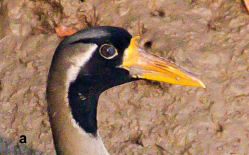Is the Masked Finfoot Asia’s next avian extinction?
A new paper published in the UK-based ornithological journal, Forktail: Journal of Asian Ornithology revealed a very small, still declining global population of the Masked Finfoot

Once upon a time, the now-endangered Finfoot birds ranged widely across the lowlands of north-east India, Bangladesh and South-East Asia. However, the fate of the Masked Finfoot is intertwined with the fate of tropical Asia's forested rivers.
As the region's rivers get increasingly disturbed by development, the last populations of the finfoots are quickly fading away, said a press release.
Few species of birds in Asia are as threatened as the iconic Masked Finfoot, currently listed as 'Endangered' on the IUCN Red List. Globally, there are only three species of finfoots belonging to a unique family of duck-like waterbirds found across the tropics of Asia, Africa and the Americas. Asia's Masked Finfoot is the least known of the three, and the most imperilled.
A new paper published in the UK-based ornithological journal, Forktail: Journal of Asian Ornithology involving a team of conservation scientists and bird experts from the University of Cambridge, BirdLife International, Wildlife Conservation Society and Mahidol University revealed a very small, still declining global population of the Masked Finfoot. Available data compiled by the researchers across all countries where found indicates that the present population of the Finfoot may not exceed 304 adult individuals, a number far smaller than previously thought and the vast majority in small area in Bangladesh. The species has evidently suffered a spectacular decline within a very short period and now qualifies to be recognised as 'Critically Endangered' – the highest level of endangerment among species.

Sayam Chowdhury, the paper's lead author and a leading expert on the Masked Finfoot conducted several years research on the species in the dense mangrove forests of Bangladesh's famed Sundarbans. He noted that the available evidence showed that the Masked Finfoot now only breeds in Bangladesh and Cambodia. "Our assessment of the species across its distribution is grim. We found no recent records in Thailand and Malaysia, where the species was once regularly encountered. Our new estimate of its global population, drawing from recent survey data and published works, suggests that the Masked Finfoot is in greater danger of extinction than any other similarly sized waterbird", noted Chowdhury.
The small size of remaining populations of the Masked Finfoot, and the relatively low density of the species, means that it is especially vulnerable to a variety of man-made threats. Dr Simon Mahood, senior technical advisor for the Wildlife ConservationSociety in Cambodia and a co-author on the paper observed that, "habitat loss and disturbance by people are clearly the most important threats to the Masked Finfoot and many other bird species that depend on riverine habitats. Low-lying, forested wetlands and rivers across South-East Asia now heavily encroached upon by human activities or have been completely lost."
Jonathan Eames OBE, a co-author of the paper and BirdLife International's senior adviser in Cambodia reminisced about his observations of the Masked Finfoot during his early visits to Southeast Asia in the 1980s. "There are many, like me, who saw the finfoots at Taman Negara in Malaysia by wading neck-deep with our very first fully waterproof binoculars and with Dai who revealed finfoots to many naturalists from his boat in the mangroves of Krabi in Thailand during the 1980s. For me, the finfoot is really an icon for the state of rivers of Southeast Asia".
Dr Yong Ding Li, migratory bird coordinator for BirdLife International in Asia observed that the complex threats faced by the Masked Finfoot in the lowlands of Southeast Asia has made conservation of the species especially challenging, with the recent development in the river systems of the Lower Mekong far worsening the situation. He noted that, "The small populations of the finfoot, coupled with the lack of insurance that a captive breeding population might provide, means that the species is now on the brink of extinction. The steep decline over such a short period show that the Masked Finfoot should be uplisted to Critically Endangered to reflect the seriousness of the situation, and urgent remedial conservation measures implemented."
The authors make several recommendations, including limiting access to key Masked Finfoot sites during the breeding season, restricting the use of mono-filament gillnets that catch and kill many birds, and increased effort to protect key lowland wetland habitats. Bangladesh's Sundarbans, where a minimum of 40 breeding pairs occur, appear to be the most important site left for the Masked Finfoot, and deserves the maximum possible protection. The authors noted that detailed conservation and research recommendations already outlined more than two decades ago have so far been largely neglected, and remain fully relevant in the present day. They also called for immediate surveys to relocate the species in Myanmar, where it was once common, and develop an action plan to coordinate conservation responses.



 Keep updated, follow The Business Standard's Google news channel
Keep updated, follow The Business Standard's Google news channel















